During the last 20 years, the demand for freshwater in the Middle East and North Africa has increased significantly—particularly because this is one of the world’s most arid regions. Larger seawater reverse osmosis (RO) desalination plants have been built to meet the demand. Most of these large facilities have opted for open seawater intakes. Beach-well and infiltration galleries, traditional for smaller systems, have become impractical for the large flows. With proper intake and filtration design, these open intake systems have reliably produced low-salinity water throughout the world.
Harmful Algal Blooms
Traditional open intake RO systems do suffer from one flaw: They are susceptible to harmful algal blooms (HABs). Severe HABs can exceed millions of cell counts per liter and can severely limit plant capacity through rapid filter fouling—or stop production altogether. Near constant filter backwashing prevents the fouling, but leads to poor-quality water being sent to the RO system.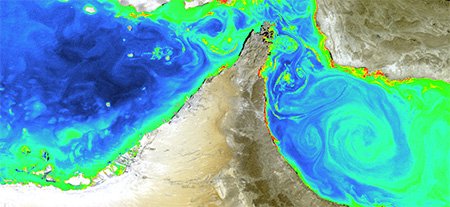 This satellite image shows chlorophyll in the Strait of Hormuz, with green representing moderate levels of concentration and yellow and red representing high levels. High levels of chlorophyll are used to measure algal activity. (Courtesy of TechWorks Marine Ltd.)
This satellite image shows chlorophyll in the Strait of Hormuz, with green representing moderate levels of concentration and yellow and red representing high levels. High levels of chlorophyll are used to measure algal activity. (Courtesy of TechWorks Marine Ltd.)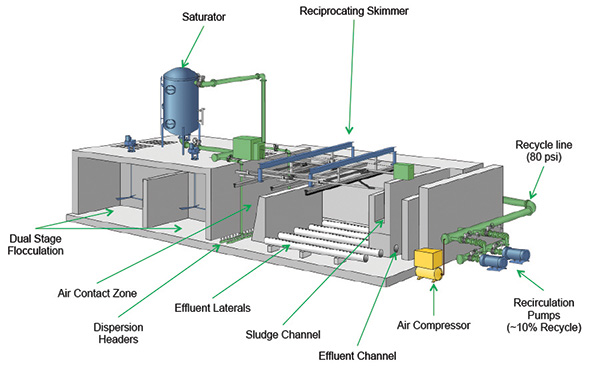 Detailed model of typical dissolved air flotation (DAF) systems (Article images and graphics courtesy of Leopold, a Xylem brand)
Detailed model of typical dissolved air flotation (DAF) systems (Article images and graphics courtesy of Leopold, a Xylem brand)Dissolved Air Flotation
Dissolved air flotation (DAF) pretreatment for open intake facilities can combat HABs. DAF clarifiers have been applied to algae-laden fresh water reservoirs and water treatment systems since the mid-1960s. During the DAF process, millions of micro-bubbles float the algae from the water. The system flocculates the algae into a small micro-floc adding a ferric-based coagulant, such as ferric chloride or ferric sulfate. These small micro-flocs are then mixed with millions of micro-air bubbles.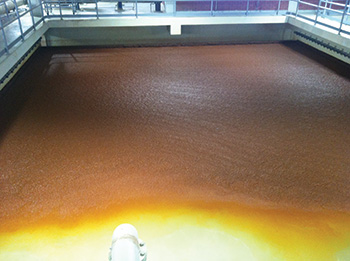 A thick blanket of algae during a bloom floats on top of a DAF basin.
A thick blanket of algae during a bloom floats on top of a DAF basin.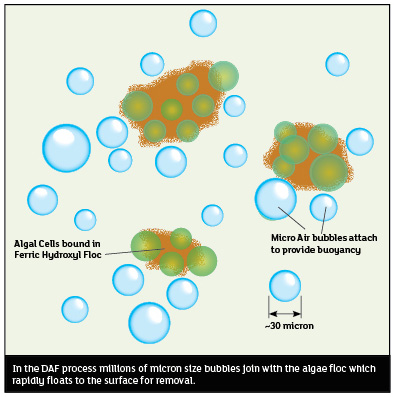 During the DAF process, millions of micron-sized bubbles join with the algal floc rapidly floating to the surface for removal.
During the DAF process, millions of micron-sized bubbles join with the algal floc rapidly floating to the surface for removal.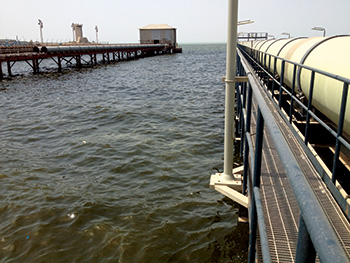 A bloom has turned the water at a desalination plant intake a dark greenish-brown hue.
A bloom has turned the water at a desalination plant intake a dark greenish-brown hue.Case Study: Kuwait
Many Gulf countries have mandated DAF pretreatment for all new seawater reverse osmosis projects that use open intake systems. However, seawater DAF applications are still in their infancy, dating back no more than 10 years. Of the few plants operating DAF for pretreatment in the Gulf, only one has borne the impact of an HAB: the Shuwaikh Seawater Reverse Osmosis Desalination Plant in Kuwait. The Shuwaikh facility incorporates a DAF system and a pressurized inside-out ultrafiltration (UF) for pretreatment. The pretreatment capacity is 350 million liters per day (MLD) with an RO output of 94.7 MLD. The plant is located next to the Port of Shuwaikh, which accommodates the majority of the country’s shipping.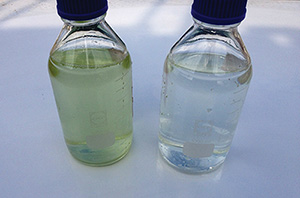 Samples of raw seawater and DAF effluent are compared side by side. The seawater has been supplemented with 100 million cells/L of algae.
Samples of raw seawater and DAF effluent are compared side by side. The seawater has been supplemented with 100 million cells/L of algae. Future Testing
The DAF process performed well throughout the Shuwaikh blooms; however, the severity of the bloom, type of algae and system algae removal were not determined. Multiple HAB species have been cultivated at Woods Hole Oceanographic Institution for DAF pilot and bench scale testing. These species included Cochlodinium polykrikoides, the most prevalent algal species identified in the 2008-2009 bloom in the Gulf. Researchers and engineers investigated coagulation techniques to lower the high charge neutralization demand from the millions of algae cells. Oxidation with sodium hypochlorite (typically less than 1 milligram per liter (mg/L)) and adjustment of the pH prior to coagulation are promising techniques. These techniques proved to lower the coagulant demand while improving the cell removal percentage. They were tested on a naturally occurring 14 million cells per liter Cochlodinium bloom in Buzzards Bay, Massachusetts, in 2011. More than 99 percent of the algae were removed with the DAF process. An algal removal challenge for the Fujairah I expansion in Fujairah, UAE, tested the effectiveness of the DAF design. A pilot with up to 100 million cells per liter in the source water required cultivated algae because the concentration was four to five times the 2008-09 bloom. The DAF pilot consistently removed more than 95 percent of the algal cells and at times exceeded 99 percent removal. The DAF pilot was followed by a gravity media filtration pilot that used the current plant’s media profile. When the algae were introduced to the DAF system, the downstream filtration system’s silt density index (SDI) actually improved, and filter head loss accumulation decreased. The algae most likely acted as a sweep floc to incorporate colloidal material in the source water. Several pilots have also been conducted on naturally occurring blooms, including a pilot at the University of Texas Marine Science Institute at Port Aransas, Texas, during a Karenia brevis bloom. Another pilot was conducted on the Antofagasta Bay in Chile, which experiences a prolonged HAB yearly. The bloom lasts up to three to four months because of the bay’s currents, which serve to feed nutrients to the algae continually during the summer months. This prolonged bloom tends to spawn a growth of many varying algal strains. Each pilot test indicated that the DAF process would be equally effective on different algal strains. The process stands as a tested tool for pretreatment where an uninterrupted supply from open intakes systems must be ensured. The demand for freshwater sources will push the evolution of desalination and related technologies in the world’s driest regions.The 2008-2009 Algal Bloom
Red tides were discovered near the UAE in August 2008. The tides were later observed off the coasts of Qatar and Iran. By spring 2009, the algal bloom spread from the Arabian Gulf through the Strait of Hormuz into the Gulf of Oman. At its height, the algal bloom stretched across 1,200 kilometers of coastline. Concerned that the bloom would damage reverse osmosis membranes and red tides would enter filtered drinking water, officials halted operations at desalination plants. The bloom, with cell counts in the tens of millions, killed thousands of fish.
Source: Abu Dhabi Water & Electricity Authority and other reports

